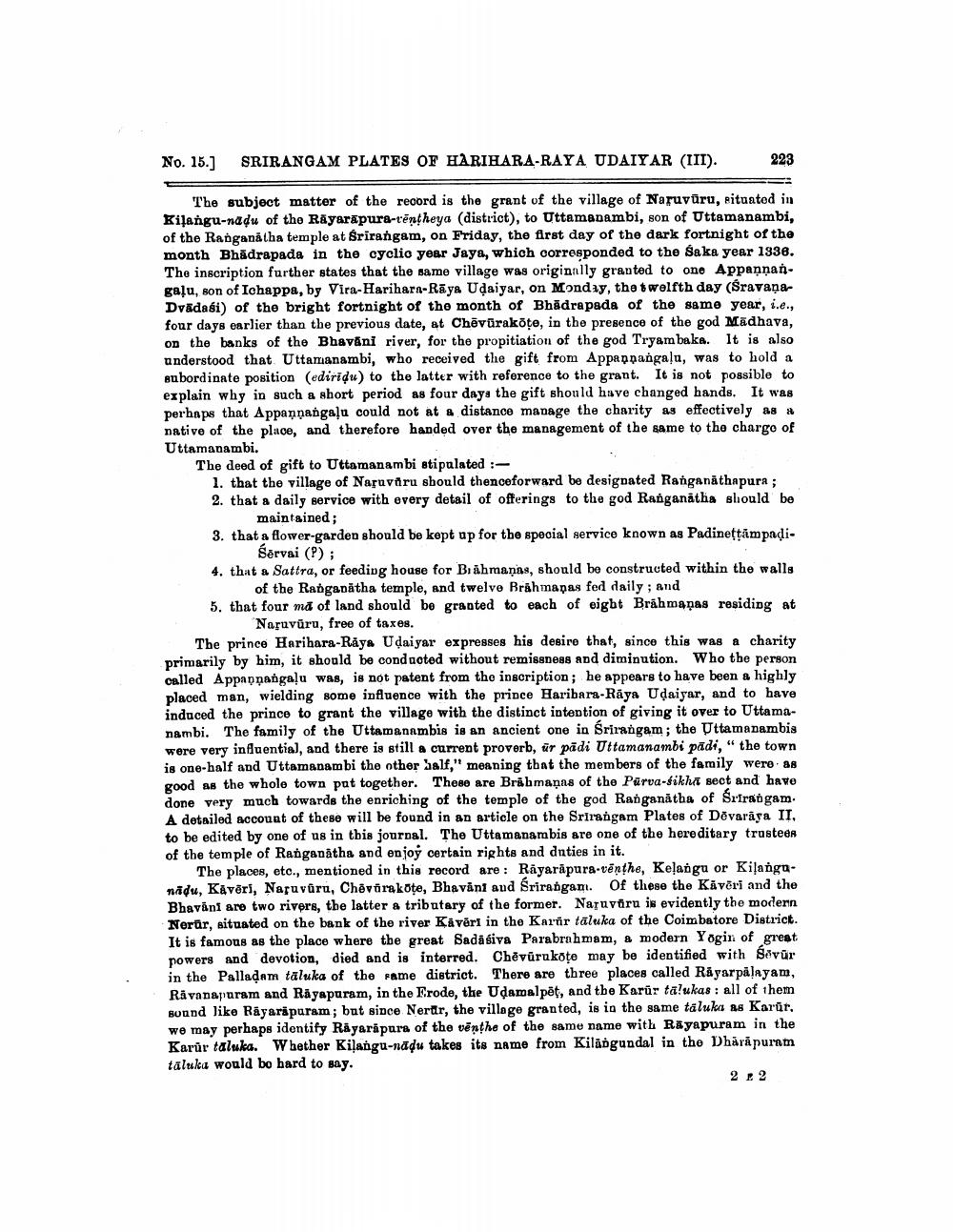________________
No. 15.]
SRIRANGAM PLATES OF HARIHARA-RAYA UDAIYAR (III).
223
The subject matter of the reoord is the grant of the village of Naruvūru, situated in Kilangu-nadu of tho RÄyarāpura-rentheya (district), to Uttamanambi, son of Uttamanambi, of the Ranganatha temple at Srirangam, on Friday, the first day of the dark fortnight of the month Bhadrapada in the cyclio year Jaya, which corresponded to the saka year 1936. The inscription further states that the same village was originally granted to one Appannan. gaļu, son of Ichappa, by Vira-Harihara-Rāya Udaiyar, on Monday, the twelfth day (SravanaDvadasi) of the bright fortnight of the month of Bhādrapada of the same year, i.e., four days earlier than the previous date, at Chēvūrakote, in the presence of the god Madhava, on the banks of the Bhavani river, for the propitiation of the god Tryam baka. It is also understood that Uttamanambi, who received the gift from Appappangalu, was to hold a subordinate position (ediridu) to the latter with reference to the grant. It is not possible to explain why in such a short period as four days the gift should have changed hands. It was perhaps that Appannangaļu could not at a distance manage the charity as effectively as * native of the place, and therefore handed over the management of the same to the chargo of Uttamanambi.
The deed of gift to Uttamanambi stipulated :
1. that the village of Naravöru sbould thenceforward be designated Ranganathapura; 2. that a daily service with every detail of offerings to the god Ranganatha sliould be
maintained; 3. that a flower-garden should be kept up for the special service known as Padinettāmpadi.
Servai (P); 4. that a Sattra, or feeding house for Brahmanas, should be constructed within the walls
of the Ranganatha temple, and twelve Brahmapas fed daily; and 5. that four ma of land should be granted to each of eight Brahmapas residing at
Naruvūru, free of taxes. The prince Harihara-Raya Udaiyar expresses his desire that, since this was a charity primarily by him, it should be conducted without remissness and diminution. Who the person called Appapnangaļu was, is not patent from the inscription; he appears to have been a highly placed man, wielding some influence with the prince Haribara-Raya Udaiyar, and to have induced the prince to grant the village with the distinct intention of giving it over to Uttamanambi. The family of the Uttamanambis is an ancient one in Srirangam; the Uttamanambis were very influential, and there is still a current proverb, tir pädi Uttamanambi padi," the town is one-half and Uttamanambi the other Salf," meaning that the members of the family were as good as the whole town pat together. These are Brāhmaṇas of the Parva-fikha sect and have done very much towards the enriching of the temple of the god Ranganatha of Srirangam. A detailed account of these will be found in an article on the Srirangam Plates of Dovaraya II, to be edited by one of us in this journal. The Uttamanambis are one of the hereditary trustees of the temple of Ranganatha and enjoy certain rights and duties in it.
The places, etc., mentioned in this record are: Rayarāpura-vēnthe, Kelangu or Kilanganadu, Kávēri, Nasuvuru, Chēvira kote, Bhaváni and Srirangan. Of these the Kávēri and the Bhavani are two rivers, the latter a tributary of the former. Nauvoru is evidently the modern Nerar, situated on the bank of the river Kävēri in the Karir tāluka of the Coimbatore District. It is famous as the place where the great Sadasiva Parabrahmam, & modern Yogin of great powers and devotion, died and is interred. Chēvūrukote may be identified with Sovur in the Palladam taluka of the fame district. There are three places called Rayarpalayam, Råvanapuram and Rayapuram, in the Erode, the Udamalpët, and the Karür ta?ukas : all of them sound like Råyaripuram; but since Nerur, the village granted, is in the same taluka as Karur, we may perhaps identify Rayaräpurs of the vēnthe of the same name with Rayapuram in the Karur taluka. Whether Kilangu-nadu takes its name from Kilaðgundal in the Dharapuram talukea would bo hard to say,




